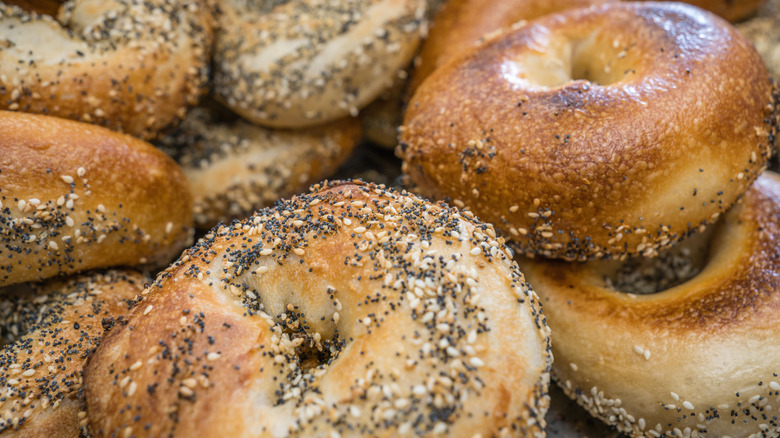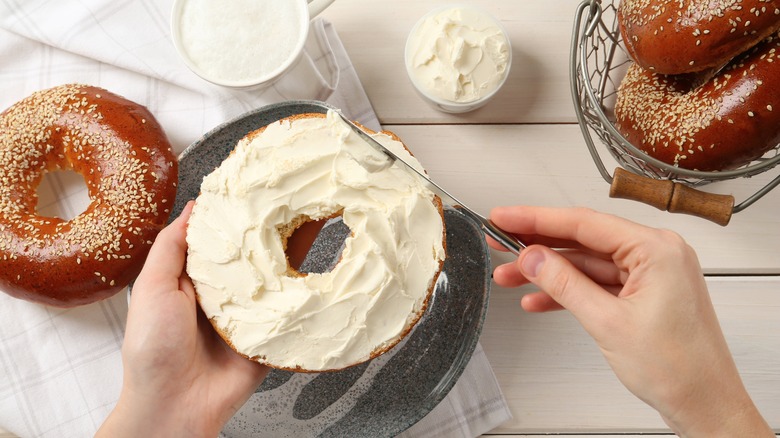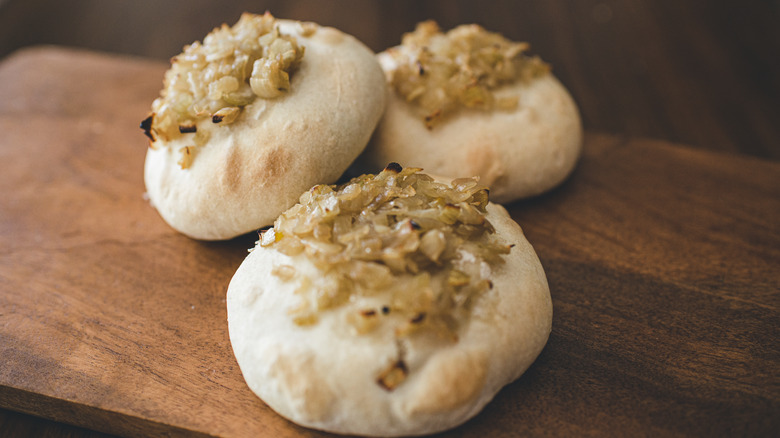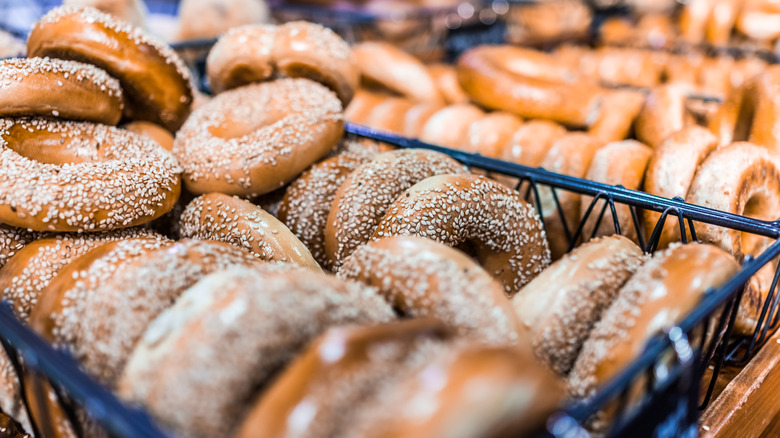The Difference Between Bagels And Bialys
You don't have to go far to get a great cup of coffee and a cheap breakfast in New York City. Yes, the city that never sleeps is full of Starbucks shops and diners, but lurking outside your hotel lobby or co-op door is likely a coffee cart, serving up strong, good coffee to construction workers and Wall Street tycoons alike in those iconic blue and white, Greek-inspired paper cups. These silver diners-on-wheels pepper the early morning streets and cater to their usuals, plus plenty of tourists looking to grab a cheap jolt of caffeine before a day of sightseeing. Most of these vendors offer some sort of food as well, ranging from donuts to egg sandwiches to tamales, per Vice. But one of the meal staples you'll see almost across the board of these sunrise vendors are bagels and bialys, both handheld, filling delights that are easy to munch on while you slowly awaken to the day.
At first glance, bagels and bialys look very similar. They are basically the same size, round, doughy, baked circles of carbs ready to be slathered with butter or cream cheese. But upon closer investigation, you'll notice subtle differences between the two, and the contrast goes beyond how they are made and what they look like. They both, in fact, came from the same European country, but while one took the nation by storm, its counterpart pretty much stayed in the Big Apple.
What is a bagel?
A definition for a bagel is hardly a necessity in America, as most people know them, eat them, and love them. Available in almost every supermarket, breakfast joint, coffee shop, and convenience store nationwide, bagels are small, round chewy bread rolls with a distinct hole in the middle that taste great toasted and coated with everything from butter and jam to cream cheese to lox. The Atlantic reports that the bagel originated in Poland sometime between the 14th and 17th centuries. Developed and perfected by Polish Jews, it was this group of people who brought bagels to America in the 19th and 20th centuries.
Many of these immigrants settled in New York City, opening up businesses and making a living doing the things they knew best, including making bagels. Many bagel connoisseurs still regard New York as where the best bagels are made but many around the country have tried to replicate them, from small bakeries to chain restaurants. At the same time that bagels arrived in the U.S., another Jewish baked specialty was making its American debut as well. A little known treat called the bialy stayed in New York while the bagel made its way into kitchens across the country.
What is a bialy?
As mentioned above, bialys almost look like the bagel's twin. But what appears to be a hole in the middle of a bialy is actually just an indentation. Depending on the baker, the indentation is as small as a thumbprint or quite a bit larger, but it does not go all the way through the dough. The dent is filled with flavorings like minced onions, garlic, and poppy seeds, per What's Cooking America, and the dough noticeably lacks the characteristic sheen that is so characteristic of bagels. This is because bagels are boiled before they are baked, and bialys are not. The website explains that bialys came to New York from Bialystok, Poland and, while still popular within the city's Jewish community, the once impressive number of bialy bakeries in New York has dwindled down to a mere handful. Mental Floss goes on to say that finding fresh bialys outside of New York is difficult.
While bagels can be loaded with schmears and sweet spreads or be built into huge sandwiches, Allrecipes suggests that the humble bialy is best warm, split, and slathered with melted butter. Because of its elusiveness, your options to get your hands on a bialy may lie in making your own, or ordering them from a reputable Jewish deli/bakery in New York, like Russ & Daughters.
Are the two really so different?
Some may claim that the bialy is a type of bagel — a different version — so to speak, but many disagree, saying that it should be labeled as its own food altogether, via Food Republic. Allrecipes agrees, suggesting that bialys are more in the category of rolls than they are bagels. Bagels are made with high gluten flour to achieve their signature hard exterior and chewy texture. Bialys' consistency is more bread-like due to their not being boiled; they also contain large air bubbles once baked, making it all the more delightful when butter gets trapped inside the holes.
Finally, unlike flavored bagels, which are often completely coated with toppings, like everything seasoning, sesame seeds, and onions, the features on a bialy are usually limited to the indentation, per Allrecipes. Both will give you a satisfying fix for breakfast, or any time of the day, but you'll definitely be part of a special few if you enjoy the rare bialy.



